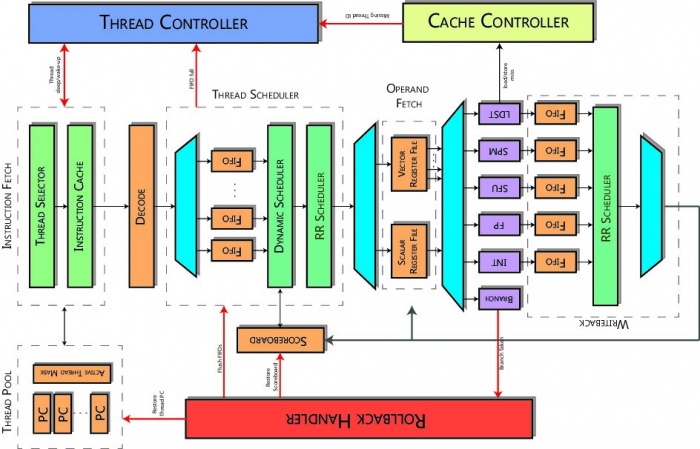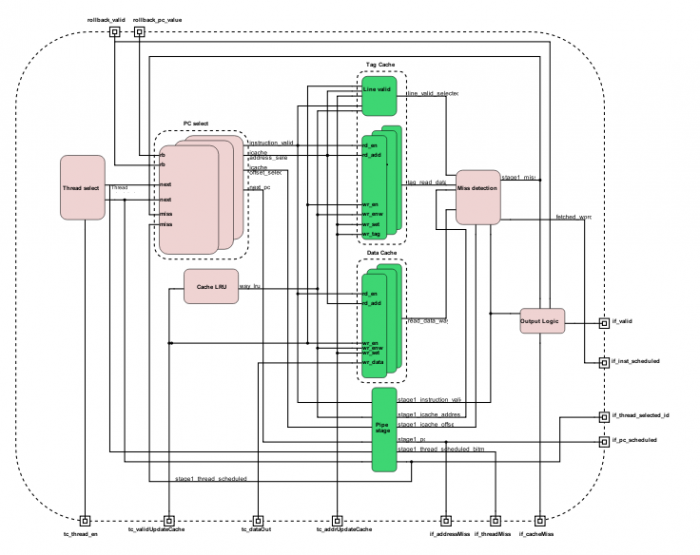Difference between revisions of "Core"
(→Cache LRU) |
(→Tag and Data instruction cache) |
||
| Line 33: | Line 33: | ||
=== Tag and Data instruction cache === | === Tag and Data instruction cache === | ||
| + | The tag and data cache are accessed in mode, using the same input. The caches are read-enabled only if the current instruction is valid. The result is validated only if there is one hit. | ||
| + | |||
| + | A line is registered as valid if some instruction are coming from memory for that way. The line_valid is registered per way too. It's important to notice a cut-through for validity check operation: if the instruction updating is relative to and address equals to the selected one, the valid output signal is instantly asserted. | ||
| + | |||
| + | if ( tc_valid_update_cache && way_lru == way ) | ||
| + | line_valid[tc_addr_update.index] <= 1; | ||
| + | if ( tc_valid_update_cache && way_lru == way && tc_addr_update.index == icache_address_selected.index) | ||
| + | line_valid_selected[way] <= 1; //cut-through | ||
| + | else | ||
| + | line_valid_selected[way] <= line_valid[icache_address_selected.index] & instruction_valid; | ||
| + | |||
| + | In order to have the signal about the current scheduled thread aligned with the available data at the caches output, we need to register this signals: PC, instruction_valid, line_valid, address, thread_id. | ||
=== Hit/miss detection === | === Hit/miss detection === | ||
Revision as of 11:50, 22 September 2017
The core is based on a RISC in-order pipeline. Its control unit is intentionally kept lightweight. The architecture masks memory and operation latencies by heavily relying on hardware multithreading. By ensuring a light control logic, the core can devote most of its resources for accelerating computing in highly data-parallel kernels. In the hardware multithreading nuplus architecture, each hardware thread has its own PC, register file, and control registers. The number of threads is user configurable. A nuplus hardware thread is equivalent to a wavefront in the AMD terminology and a CUDA warp in the NVIDIA terminology. The processor uses a deep pipeline to improve clock speed.
All threads share the same compute units. Execution pipelines are organized in hardware vector lanes (like vector processors, each operator is replicated N times). Each thread can perform a SIMD operation on independent data, while data are organized in a vector register file. The core supports a high-throughput non-coherent scratchpad memory, or SPM (corresponding to the shared memory in the NVIDIA terminology). The SPM is divided in a parameterized number of banks based on a user-configurable mapping function. The memory controller resolves bank collisions at run-time ensuring a correct execution of SPM accesses from concurrent threads. Coherence mechanisms incur a high latency and are not strictly necessary for many applications.
Contents
Instruction fetch stage
Instruction Fetch stage schedules the next thread PC from the eligible thread pool, handled by the Thread Controller. Available threads are scheduled in a Round Robin fashion. Furthermore, at the boot phase, the Thread Controller can initialize each thread PC through a specific interface.
Thread & PC selection
A thread is selected by all the possible eligible ones using an external signal coming from thread controller unit. Anyway, an internal round robin arbiter raises the threads in a fair mode. A different thread is elected at each clock cycle, so nu+ can be classified as a fine-grained multithreaded architecture.
The elected thread number selects a specific PC that is modified on the base of some thread-related events: if there is not a cache miss or if there is not a rollback - else the valid signal is invalidated.
if ( tc_job_valid && thread_id == tc_job_thread_id ) // new job next_pc[thread_id] <= tc_job_pc; else if ( rollback_valid[thread_id] ) // rollback next_pc[thread_id] <= rollback_pc_value[thread_id]; else if ( stage1_miss[thread_id] && stage1_thread_scheduled_id == thread_id ) // Inst miss next_pc[thread_id] <= next_pc[thread_id] - address_t'( 3'd4 ); else if ( thread_scheduled_bitmap[thread_id] ) // Normal execution next_pc[thread_id] <= next_pc[thread_id] + address_t'( 3'd4 );
Cache LRU
The Pseduo LRU works in a way described at this link, page 13.
The hit interface is enabled when you want to move a way to the MRU position, i.e. when a hit is performed.
THe update interface is enabled when you want to request LRU way to fill it. This happen when new instruction cahce line arrives from memory. No replacement is needed beacause the instruction memory area is uncoherent.
Tag and Data instruction cache
The tag and data cache are accessed in mode, using the same input. The caches are read-enabled only if the current instruction is valid. The result is validated only if there is one hit.
A line is registered as valid if some instruction are coming from memory for that way. The line_valid is registered per way too. It's important to notice a cut-through for validity check operation: if the instruction updating is relative to and address equals to the selected one, the valid output signal is instantly asserted.
if ( tc_valid_update_cache && way_lru == way ) line_valid[tc_addr_update.index] <= 1; if ( tc_valid_update_cache && way_lru == way && tc_addr_update.index == icache_address_selected.index) line_valid_selected[way] <= 1; //cut-through else line_valid_selected[way] <= line_valid[icache_address_selected.index] & instruction_valid;
In order to have the signal about the current scheduled thread aligned with the available data at the caches output, we need to register this signals: PC, instruction_valid, line_valid, address, thread_id.
Hit/miss detection
Output logic
The instruction cache is set associative and has two stages. Once an eligible thread is selected, Instruction Fetch reads its PC, and determines if the next instruction cache line is already in instruction cache memory or not. In the first stage each way has a bank of memory containing tag values and valid bits for the cache sets. This stage reads the way memories in parallel and passes those data to the second stage. The next stage tag memory has one cycle of latency, so the next stage handles the result. This stage compares the way tags read in the last stage, if they match, it is a cache hit. In this case, this stage issues the instruction cache data address to instruction cache data memory. If a miss occurs an instruction memory transaction is issued to the Network Interface and the thread is blocked until the instruction line is not retrieved from main memory.
Finally, this module handles the PC restoring in case of rollback. When a rollback occurs and the rollback signals are set by Rollback Handler stage, the Instruction Fetch module overwrites the PC of the thread that issued the rollback.
Decode stage
Decode stage decodes fetched instruction from Instruction Fetch and produces the control signals for the datapath directly from the instruction bits. Output dec_instr helps execution and control modules to manage the issued instruction and is propagated in each pipeline stage. Instruction type are presented in the ISA section.
Instruction scheduler stage
Fetched instructions are stored in FIFOs in this stage, one per thread. The Dynamic Scheduler checks data hazard and states which thread can be fetched in the Operand Fetch; this is done through a light scoreboarding system, each thread has its own scoreboard. There are no structural hazard check, it is done in Writeback stage.
Operand fetch stage
Operand Fetch prepares operands to the Execution pipeline. As said before, nu+ core supports SIMD operations, for this purpose it has two register files: a scalar register file (SRF) and a vector register file (VRF). The SRF is general purpose register and in the base configuration it has 64 registers of 32-bits. Dually, the VRF register size has a scalar register file for each hardware lane, in other word each vector register is composed by hardware lane number of scalar register; in the base configuration the VRF has 64 vector registers and each vector register is composed of $16$ scalar register of 32-bits. Each thread has its own register file.
Integer Arithmetic & Logic unit
A single stage executes simple integer instructions, as integer operations, comparisons and bitwise logical operations.
Scratchpad unit
This unit is described in the dedicated scratchpad page.
Load/Store unit
This unit is described in the dedicated load/store subsection inside the coherence section.
Floating point unit
A multistage floating point instructions, supports all basic FP operation according to the IEEE-754-2008 standard.
Barrier unit
This unit is described in the dedicated synchronization section.
Branch unit
This stage handles conditional and unconditional jumps and traps. It signals to the Rollback Handler when a jump must be taken or not.
Writeback stage
Writeback stage detects on-the-fly structural hazard on register writeback and extends load signed operations. The integer, memory, and floating point execution pipelines have different lengths, so instructions issued in different cycles could arrive at the Writeback in the same cycle. Furthermore, due to collisions, a load/store to the scartchpad memory can have variable latency which is unknown at compile time, and this can result in an unpredictable structural hazard on Writeback. The Writeback module can resolves collision on itself on-the-fly without losing effectiveness.
Rollback handler
Rollback Handler restores PCs and scoreboards of the threads that issued a rollback. In case of jump or trap, the Brach module in the Execution pipeline issues a rollback request to this stage, and passes to the Rollback Handler the thread ID that issued the rollback, the old scoreboard and the PC to restore. Furthermore, the Rollback Handler flushes all issued requests from the thread still in the pipeline.
Thread controller
Thread Controller handles eligible thread pool. This module blocks threads that cannot proceed due cache misses or scoreboarding. Dually, Thread Controller handles threads wake-up when the blocking conditions are no more trues.
Furthermore, the Thread Controller interfaces core instruction cache and the higher level in the memory hierarchy. Instruction miss requests are directly forwarded to the memory controller through the network on chip.
The third task performed is to accept the jobs from host interface and redirect them to the thread controller.
Note: a load/store miss blocks the corresponding thread until data is gather from main memory throughput the ib_fifo_full signal.


